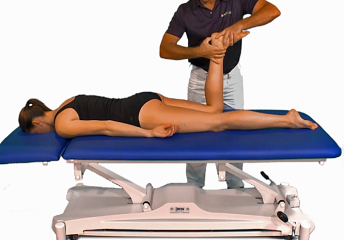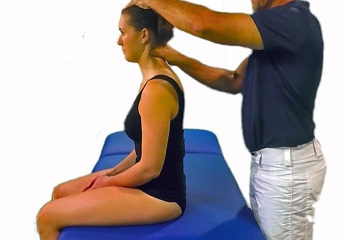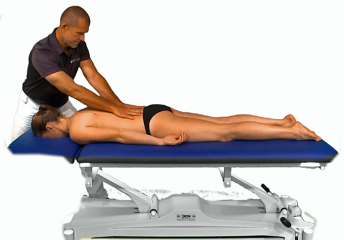Tibiofibulární kloub (TIBIOFIBULAR JOINT)
TIBIOFIBULÁRNÍ KLOUB
Poloha pacienta: Leží na zádech. Ošetřovaná dolní končetina je pokrčená a opřená chodidlem o podložku.
Postavení terapeuta: Přisedne špičku pacientovy nohy a jednou rukou fixuje horní část tibie z mediální strany.
Provedení: Terapeut druhou rukou uchopí hlavičku fibuly tak, že pokrčený ukazovák je v podkolenní jamce a palec sahá až na anteriorní plochu fibuly. První ruka, která fixuje tibii, položí palec na nehet palce druhé ruky. Společným pohybem obou rukou – po obvodu bérce, terapeut provádí posun směrem posteriorním nebo anteriorním.
Technika: Diagnostická i terapeutická - čekání v předpětí nebo repetitvní mobilizace.
Chyby: Bolestivý kontakt stiskem mezi palcem a ukazovákem.
TIBIOFIBULAR JOINT
Patient position: He (she) is lying on his back. The treated lower limb is bent and rested with the foot on the mat.
Position of the therapist: He (she) places the toe of the patient's leg and fixes the upper part of the tibia from the medial side with one hand.
Execution: The therapist grasps the head of the fibula with the other hand so that the bent index finger is in the popliteal fossa and the thumb reaches the anterior surface of the fibula. The first hand, which fixes the tibia, places the thumb on the thumb nail of the other hand. By joint movement of both hands – along the circumference of the lower leg, the therapist performs a shift in the posterior or anterior direction.
Technique: Diagnostic and therapeutic - waiting in pretension or repetitive mobilization.
Errors: Painful pressure contact between thumb and forefinger.
SOUVISEJÍCÍ

Kolenní kloub – zaúhlení (KNEE JOINT – ANGULATION)

Kolenní kloub – trakce vleže na zádech (KNEE JOINT – TRACTION LYING ON THE SUPINE POSITION)

Kolenní kloub – trakce vleže na břiše (KNEE JOINT – TRACTION LYING ON THE PRONE POSITION)

Tibiofibulární kloub (TIBIOFIBULAR JOINT)

Patelofemorální kloub (PATELOFEMORAL JOINT)



















